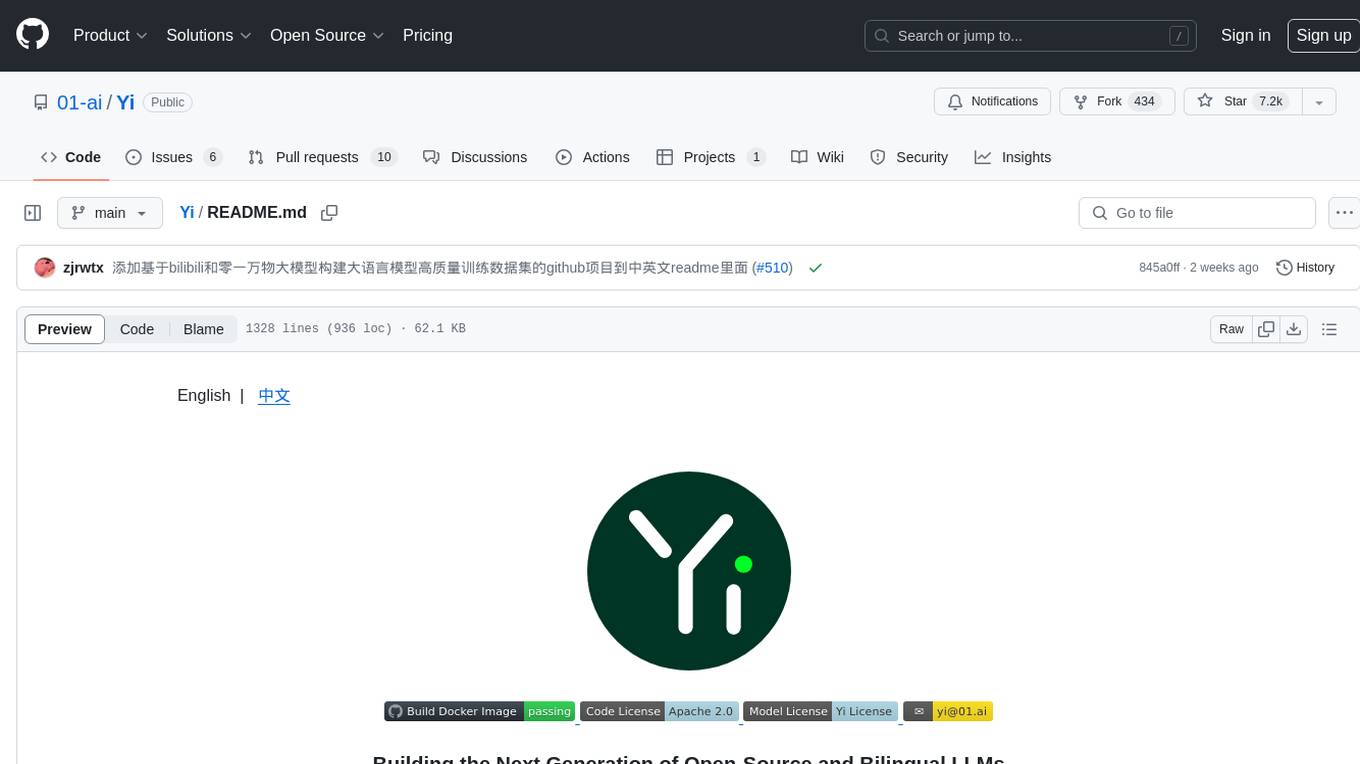
ShapeLLM
[ECCV 2024] ShapeLLM: Universal 3D Object Understanding for Embodied Interaction
Stars: 86
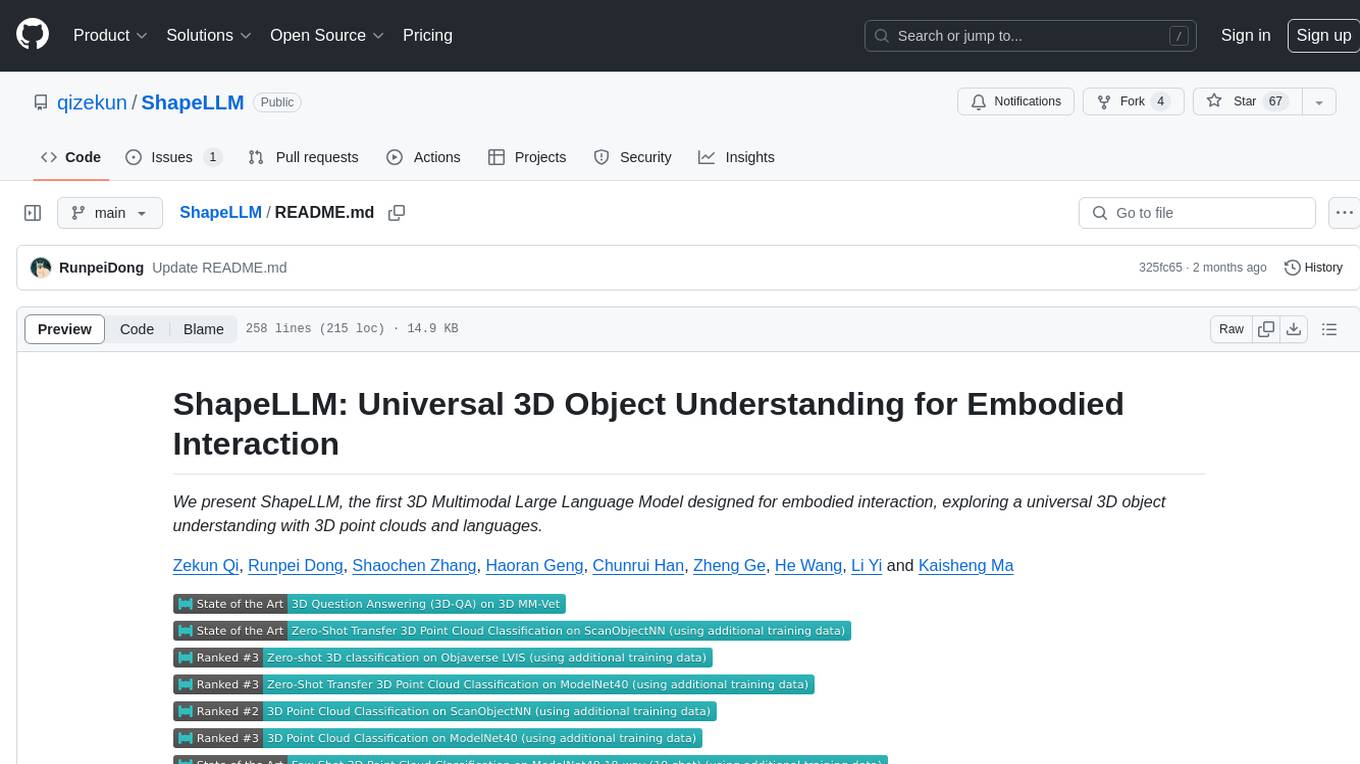
ShapeLLM is the first 3D Multimodal Large Language Model designed for embodied interaction, exploring a universal 3D object understanding with 3D point clouds and languages. It supports single-view colored point cloud input and introduces a robust 3D QA benchmark, 3D MM-Vet, encompassing various variants. The model extends the powerful point encoder architecture, ReCon++, achieving state-of-the-art performance across a range of representation learning tasks. ShapeLLM can be used for tasks such as training, zero-shot understanding, visual grounding, few-shot learning, and zero-shot learning on 3D MM-Vet.
README:
We present ShapeLLM, the first 3D Multimodal Large Language Model designed for embodied interaction, exploring a universal 3D object understanding with 3D point clouds and languages.
Zekun Qi, Runpei Dong, Shaochen Zhang, Haoran Geng, Chunrui Han, Zheng Ge, Li Yi and Kaisheng Ma
1. ShapeLLM is the first 3D Multimodal Large Language Model designed for embodied interaction.
2. ShapeLLM supports single-view colored point cloud input, which can be effortlessly obtained from RGBD cameras.
3. We introduce a robust 3D QA benchmark, 3D MM-Vet, encompassing various variants including single-view, noise jitter, etc.
4. We extend the powerful point encoder architecture, ReCon++, achieving state-of-the-art performance across a range of representation learning tasks.
- Clone this repository and navigate to ShapeLLM folder
git clone https://github.com/qizekun/ShapeLLM.git
cd ShapeLLM- Install Package
conda create -n shapellm python=3.10 -y
conda activate shapellm
pip install --upgrade pip # enable PEP 660 support
pip install -e .- Install additional packages for training cases
pip install -e ".[train]"
pip install flash-attn --no-build-isolation- Install PointNet++
pip install "git+https://github.com/erikwijmans/Pointnet2_PyTorch.git#egg=pointnet2_ops&subdirectory=pointnet2_ops_lib"Please check out our Model Zoo for all public ShapeLLM checkpoints.
Chat about point clouds using CLI interface. It also supports multiple GPUs, 4-bit and 8-bit quantized inference.
python -m llava.serve.cli \
--model-path qizekun/ShapeLLM_13B_general_v1.0 \
--pts-file assets/instrument.npyConsistent with LLaVA, we adopt a two-stage training approach. In the first stage, we solely fine-tune the projector for semantic alignment. In the second stage, we conduct full fine-tuning using Instruction Following data.
Download data following DATA, organize the data as follows in ./playground/data/shapellm/,
│playground/data/shapellm/
├── cap3d_objaverse_785k.json
├── cap3d_objaverse_sft_45k.json
├── gapartnet_sft_27k_openai.json
├── gapartnet_pcs
│ ├── Box_100129_0_0.npy
│ └── ...
└── cap3d_pcs
├── 00000054c36d44a2a483bdbff31d8edf.pt
└── ...
Furthermore, ShapeLLM utilizes the Large version of ReCon++ as the point encoder.
You need to download the ReCon++ weight and save it to ./checkpoints/recon/large.pth.
│checkpoints/recon/
└── large.pth
1. Feature Alignment Stage
sh scripts/pretrain.sh
2. Visual Instruction Tuning Stage
sh scripts/finetune.sh
The training takes around 14 hours for ShapeLLM-13B on 8x A100 (80G). It takes around 7 hours for ShapeLLM-7B.
Evaluate 3D MLLMs for integrated capabilities and embodied interaction capabilities, run the script:
sh scripts/eval/mmvet.sh
Using GPT-4 to calulate the 3D MM-Vet score:
sh scripts/eval/eval_mmvet.sh
Evaluate the performance of ShapeLLM on the GApartNet dataset, run the script:
sh scripts/eval/gapartnet_ref.sh
Calucate the generative 3D visual grounding accuracy:
sh scripts/eval/eval_gapartnet.sh
Please check out our Model Zoo for all public ReCon++ checkpoints.
Download and organize data following DATA.
If you encounter issues accessing Huggingface, please use export HF_ENDPOINT=https://hf-mirror.com.
ReCon++ adopts a two-stage pre-training approach, initially conducting generative pre-training in either random or causal form, followed by cross-modal contrastive learning. It is worth noting that we employ a gradient stopping strategy for transfer learning tasks, while we do not use gradient stopping for zero-shot tasks.
sh ReConV2/scripts/pretrain_reconstruch.sh <exp_name>
sh ReConV2/scripts/pretrain_contrast.sh <exp_name> <path/to/stage1-pre-trained/model>
| Model | Version | OBJ_BG | OBJ_ONLY | PB_T50_RS | MN-40 1k | MN-40 8k |
|---|---|---|---|---|---|---|
| ACT | Small | 93.29% | 91.91% | 88.21% | 93.7% | 94.0% |
| ReCon | Small | 95.35% | 93.80% | 91.26% | 94.5% | 94.7% |
| PointGPT | Base | 95.8% | 95.2% | 91.9% | 94.4% | 94.6% |
| ReCon++ | Base | 98.62% | 96.21% | 93.34% | 94.6% | 94.8% |
| ReCon++ | Large | 98.80% | 97.59% | 95.25% | 94.8% | 95.0% |
Fine-tuning with the default configuration, run the script:
bash ReConV2/scripts/cls.sh <GPU> <exp_name> <path/to/pre-trained/model>
Test&Voting with the default configuration, run the script:
bash ReConV2/scripts/test.sh <GPU> <exp_name> <path/to/best/fine-tuned/model>
| Model | Version | 5w10s (%) | 5w20s (%) | 10w10s (%) | 10w20s (%) |
|---|---|---|---|---|---|
| ACT | Small | 96.8 ± 2.3 | 98.0 ± 1.4 | 93.3 ± 4.0 | 95.6 ± 2.8 |
| ReCon | Small | 97.3 ± 1.9 | 98.9 ± 1.2 | 93.3 ± 3.9 | 95.8 ± 3.0 |
| PointGPT | Large | 98.0 ± 1.9 | 99.0 ± 1.0 | 94.1 ± 3.3 | 96.1 ± 2.8 |
| ReCon++ | Large | 98.0 ± 2.3 | 99.5 ± 0.8 | 94.5 ± 4.1 | 96.5 ± 3.0 |
Few-shot with the default configuration, run the script:
sh ReConV2/scripts/fewshot.sh <GPU> <exp_name> <path/to/pre-trained/model> <way> <shot> <fold>
| Model | Version | Objaverse-LVIS | ModelNet40 | ScanObjectNN |
|---|---|---|---|---|
| OpenShape | Base | 46.8% | 84.4% | 52.2% |
| Uni3D | Base | 51.7% | 86.3% | 63.8% |
| Uni3D | Large | 53.1% | 86.3% | 58.2% |
| ReCon++ | Base | 53.2% | 86.5% | 63.6% |
| ReCon++ | Large | 53.7% | 87.3% | 65.4% |
In the pre-training process, Zero-shot evaluation is enabled by default. Zero-shot with the default configuration, run the script:
bash ReConV2/scripts/zeroshot.sh <GPU> <exp_name> <path/to/pre-trained/model>
3D MM-Vet is a carefully crafted multi-level 3D QA benchmark that consists of 59 unique 3D models and 232 human-written questions and answers with rich content.
The test data and scripts have been uploaded to Hugging Face. You can also locate the evaluation scripts from the codebase of ShapeLLM.
Furthermore, we propose 3D MM-Vet-C, which contains three variants: single-view, jitter, and rotation. They represent extracting partial point clouds of the front view field of view, adding Gaussian noise to the point cloud xyz, and random rotation on the x, y, and z axes, respectively.
Here is a more detailed explanation of each variant:
- Single-view: This variant focuses on the model's ability to understand the 3D object from a single viewpoint. To create the single-view variant, we extract the front-view point cloud of each model.
- Jitter: This variant tests the model's robustness to noise. To create the jitter variant, we add Gaussian noise with zero mean and variance of 0.01 to the point cloud xyz.
- Rotation: This variant examines the model's ability to understand the 3D scene from different viewpoints. To create the rotation variant, we randomly apply 30 degrees of random rotation on the x, y, and z axes.
We believe that 3D MM-Vet and 3D MM-Vet-C are valuable resources for the 3D QA community. They can be used to evaluate the performance of existing models and to develop new models that are better at understanding and reasoning about 3D objects.
We use PointVisualizaiton repo to render beautiful point cloud images, including specified color rendering and attention distribution rendering.
If you find ShapeLLM or ReCon++ useful for your research and applications, please cite using this BibTeX:
@article{qi2024shapellm,
author = {Qi, Zekun and Dong, Runpei and Zhang, Shaochen and Geng, Haoran and Han, Chunrui and Ge, Zheng and Yi, Li and Ma, Kaisheng},
title = {ShapeLLM: Universal 3D Object Understanding for Embodied Interaction},
journal = {arXiv preprint arXiv:2402.17766},
year = {2024}
}and closely related work ReCon and ACT:
@inproceedings{qi2023recon,
title={Contrast with Reconstruct: Contrastive 3D Representation Learning Guided by Generative Pretraining},
author={Qi, Zekun and Dong, Runpei and Fan, Guofan and Ge, Zheng and Zhang, Xiangyu and Ma, Kaisheng and Yi, Li},
booktitle={International Conference on Machine Learning (ICML) },
url={https://openreview.net/forum?id=80IfYewOh1},
year={2023}
}
@inproceedings{dong2023act,
title={Autoencoders as Cross-Modal Teachers: Can Pretrained 2D Image Transformers Help 3D Representation Learning?},
author={Runpei Dong and Zekun Qi and Linfeng Zhang and Junbo Zhang and Jianjian Sun and Zheng Ge and Li Yi and Kaisheng Ma},
booktitle={The Eleventh International Conference on Learning Representations (ICLR) },
url={https://openreview.net/forum?id=8Oun8ZUVe8N},
year={2023}
}This codebase is built upon LLaVA, OpenShape, ReCon and PointGPT.
For Tasks:
Click tags to check more tools for each tasksFor Jobs:
Alternative AI tools for ShapeLLM
Similar Open Source Tools

ShapeLLM
ShapeLLM is the first 3D Multimodal Large Language Model designed for embodied interaction, exploring a universal 3D object understanding with 3D point clouds and languages. It supports single-view colored point cloud input and introduces a robust 3D QA benchmark, 3D MM-Vet, encompassing various variants. The model extends the powerful point encoder architecture, ReCon++, achieving state-of-the-art performance across a range of representation learning tasks. ShapeLLM can be used for tasks such as training, zero-shot understanding, visual grounding, few-shot learning, and zero-shot learning on 3D MM-Vet.
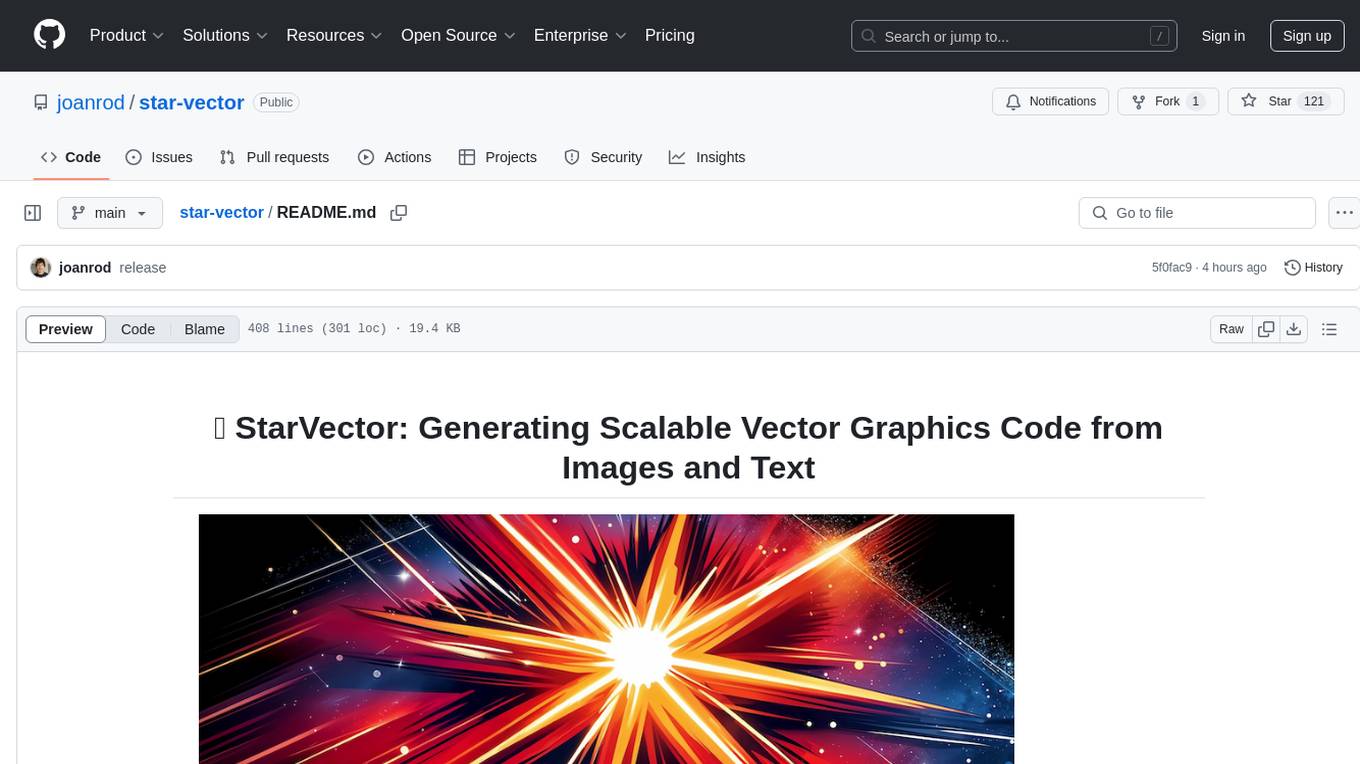
star-vector
StarVector is a multimodal vision-language model for Scalable Vector Graphics (SVG) generation. It can be used to perform image2SVG and text2SVG generation. StarVector works directly in the SVG code space, leveraging visual understanding to apply accurate SVG primitives. It achieves state-of-the-art performance in producing compact and semantically rich SVGs. The tool provides Hugging Face model checkpoints for image2SVG vectorization, with models like StarVector-8B and StarVector-1B. It also offers datasets like SVG-Stack, SVG-Fonts, SVG-Icons, SVG-Emoji, and SVG-Diagrams for evaluation. StarVector can be trained using Deepspeed or FSDP for tasks like Image2SVG and Text2SVG generation. The tool provides a demo with options for HuggingFace generation or VLLM backend for faster generation speed.
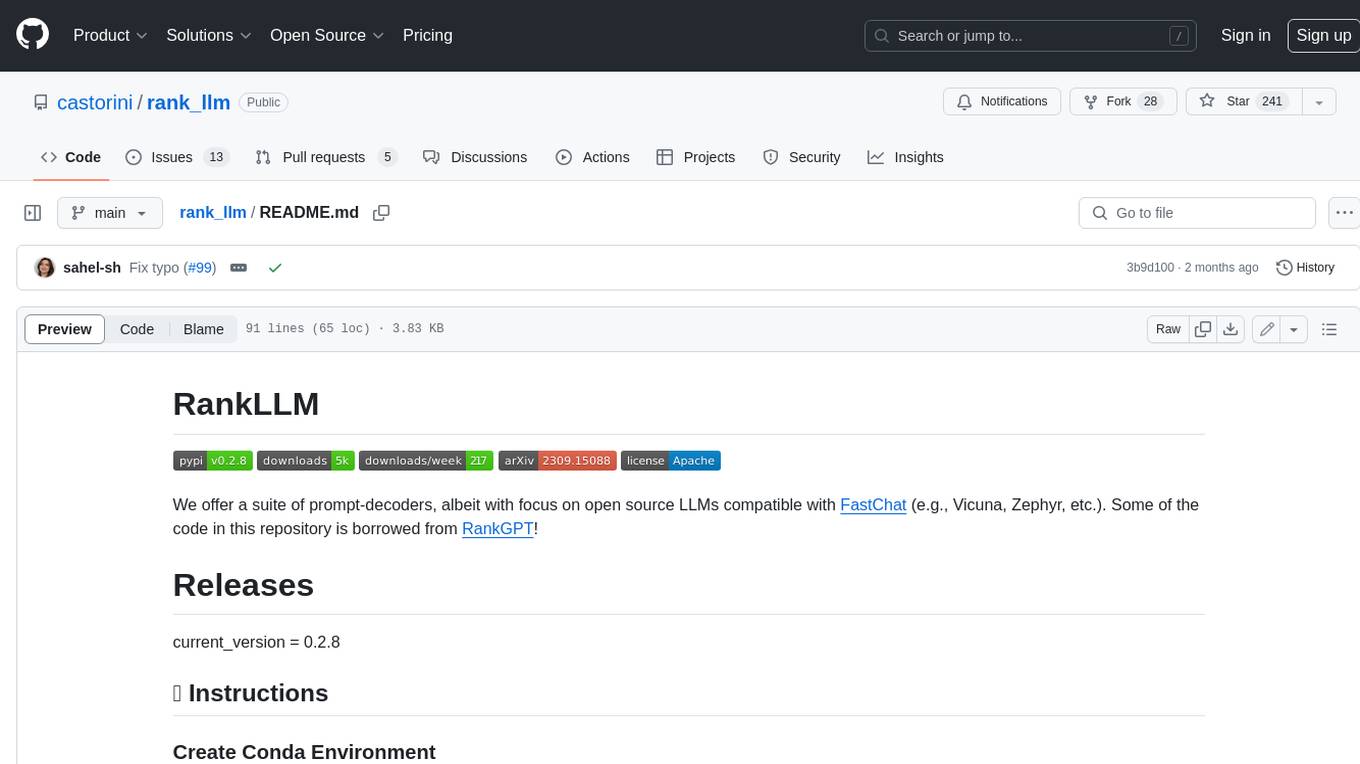
rank_llm
RankLLM is a suite of prompt-decoders compatible with open source LLMs like Vicuna and Zephyr. It allows users to create custom ranking models for various NLP tasks, such as document reranking, question answering, and summarization. The tool offers a variety of features, including the ability to fine-tune models on custom datasets, use different retrieval methods, and control the context size and variable passages. RankLLM is easy to use and can be integrated into existing NLP pipelines.
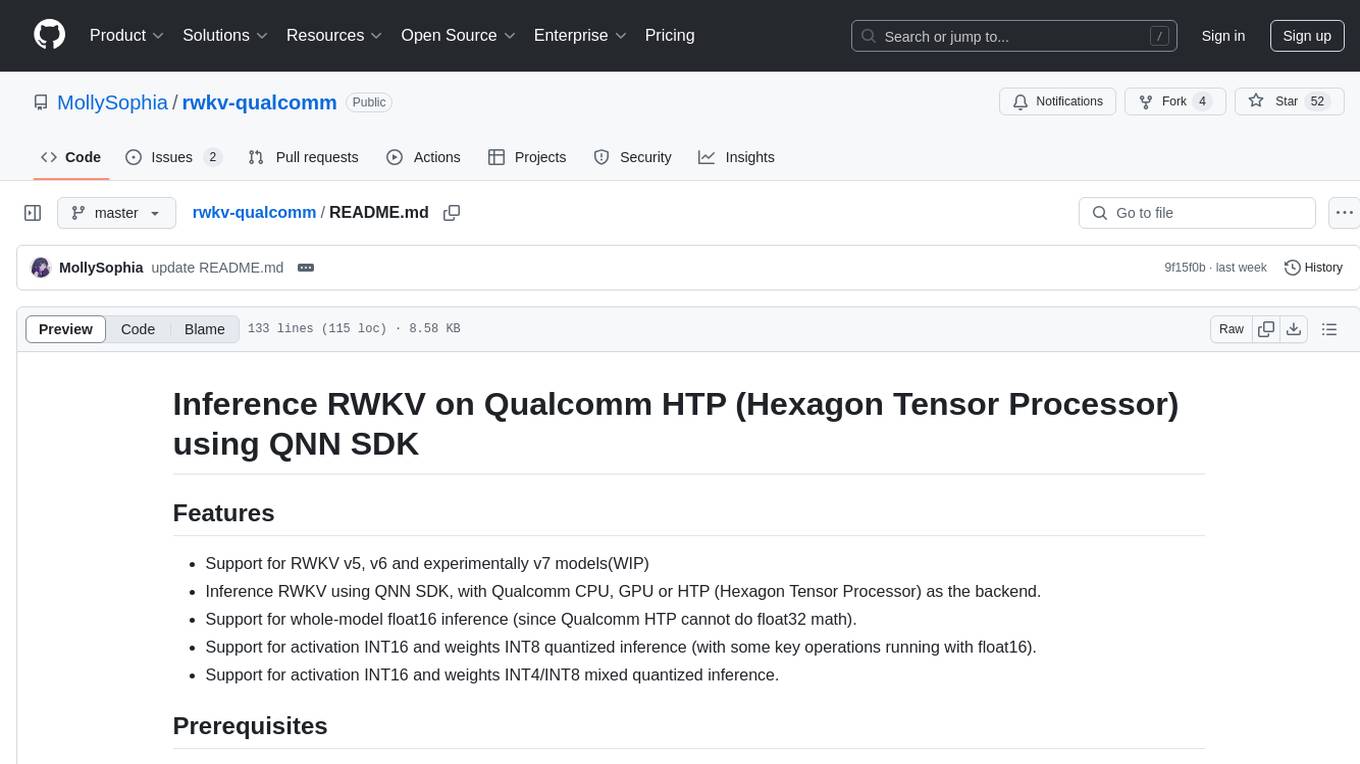
rwkv-qualcomm
This repository provides support for inference RWKV models on Qualcomm HTP (Hexagon Tensor Processor) using QNN SDK. It supports RWKV v5, v6, and experimentally v7 models, inference using Qualcomm CPU, GPU, or HTP as the backend, whole-model float16 inference, activation INT16 and weights INT8 quantized inference, and activation INT16 and weights INT4/INT8 mixed quantized inference. Users can convert model weights to QNN model library files, generate HTP context cache, and run inference on Qualcomm Snapdragon SM8650 with HTP v75. The project requires QNN SDK, AIMET toolkit, and specific hardware for verification.
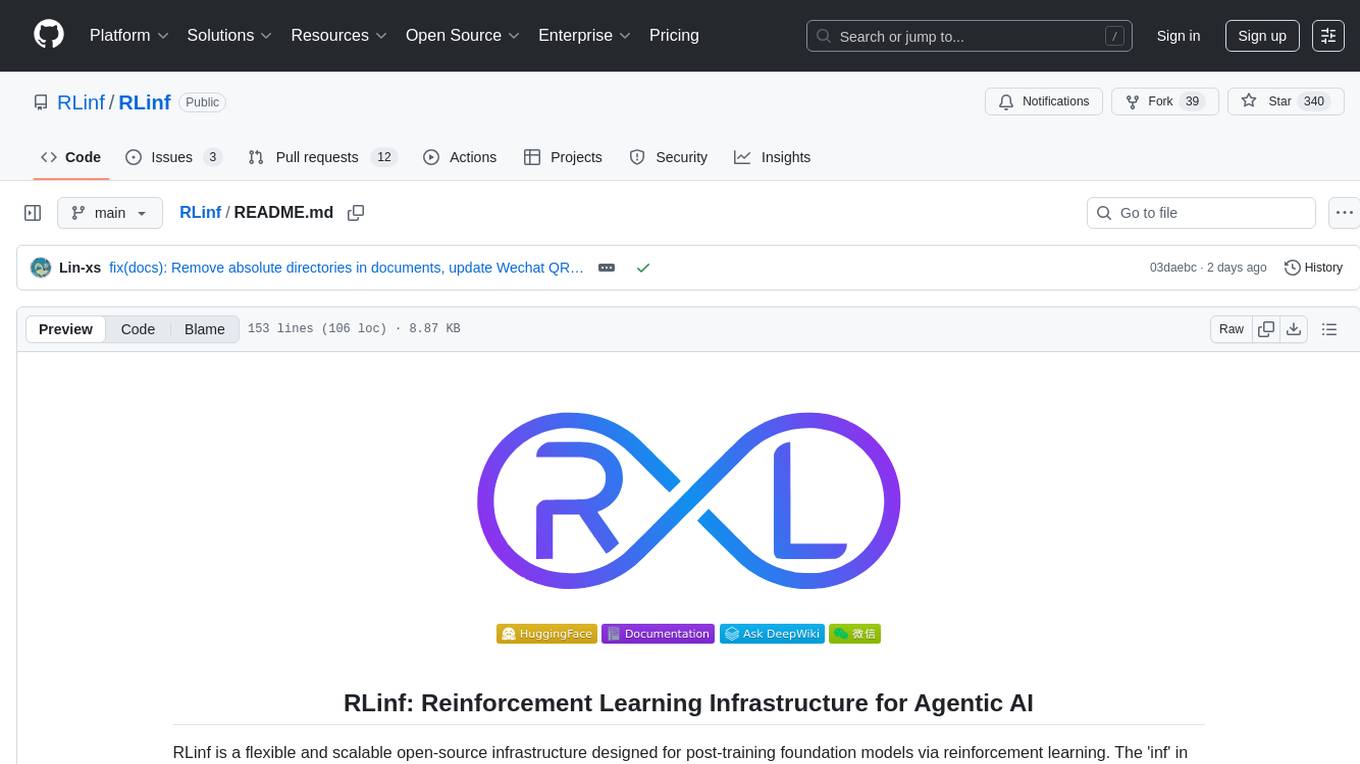
RLinf
RLinf is a flexible and scalable open-source infrastructure designed for post-training foundation models via reinforcement learning. It provides a robust backbone for next-generation training, supporting open-ended learning, continuous generalization, and limitless possibilities in intelligence development. The tool offers unique features like Macro-to-Micro Flow, flexible execution modes, auto-scheduling strategy, embodied agent support, and fast adaptation for mainstream VLA models. RLinf is fast with hybrid mode and automatic online scaling strategy, achieving significant throughput improvement and efficiency. It is also flexible and easy to use with multiple backend integrations, adaptive communication, and built-in support for popular RL methods. The roadmap includes system-level enhancements and application-level extensions to support various training scenarios and models. Users can get started with complete documentation, quickstart guides, key design principles, example gallery, advanced features, and guidelines for extending the framework. Contributions are welcome, and users are encouraged to cite the GitHub repository and acknowledge the broader open-source community.
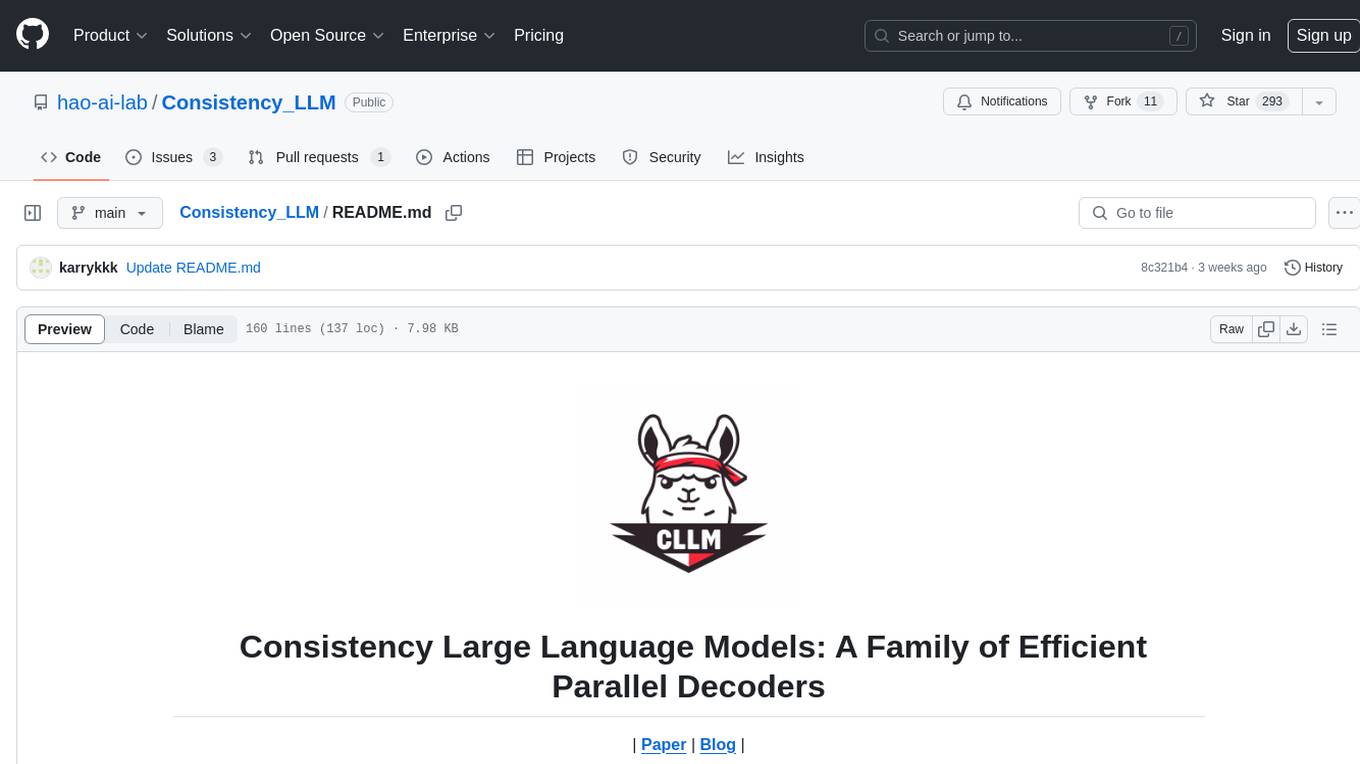
Consistency_LLM
Consistency Large Language Models (CLLMs) is a family of efficient parallel decoders that reduce inference latency by efficiently decoding multiple tokens in parallel. The models are trained to perform efficient Jacobi decoding, mapping any randomly initialized token sequence to the same result as auto-regressive decoding in as few steps as possible. CLLMs have shown significant improvements in generation speed on various tasks, achieving up to 3.4 times faster generation. The tool provides a seamless integration with other techniques for efficient Large Language Model (LLM) inference, without the need for draft models or architectural modifications.
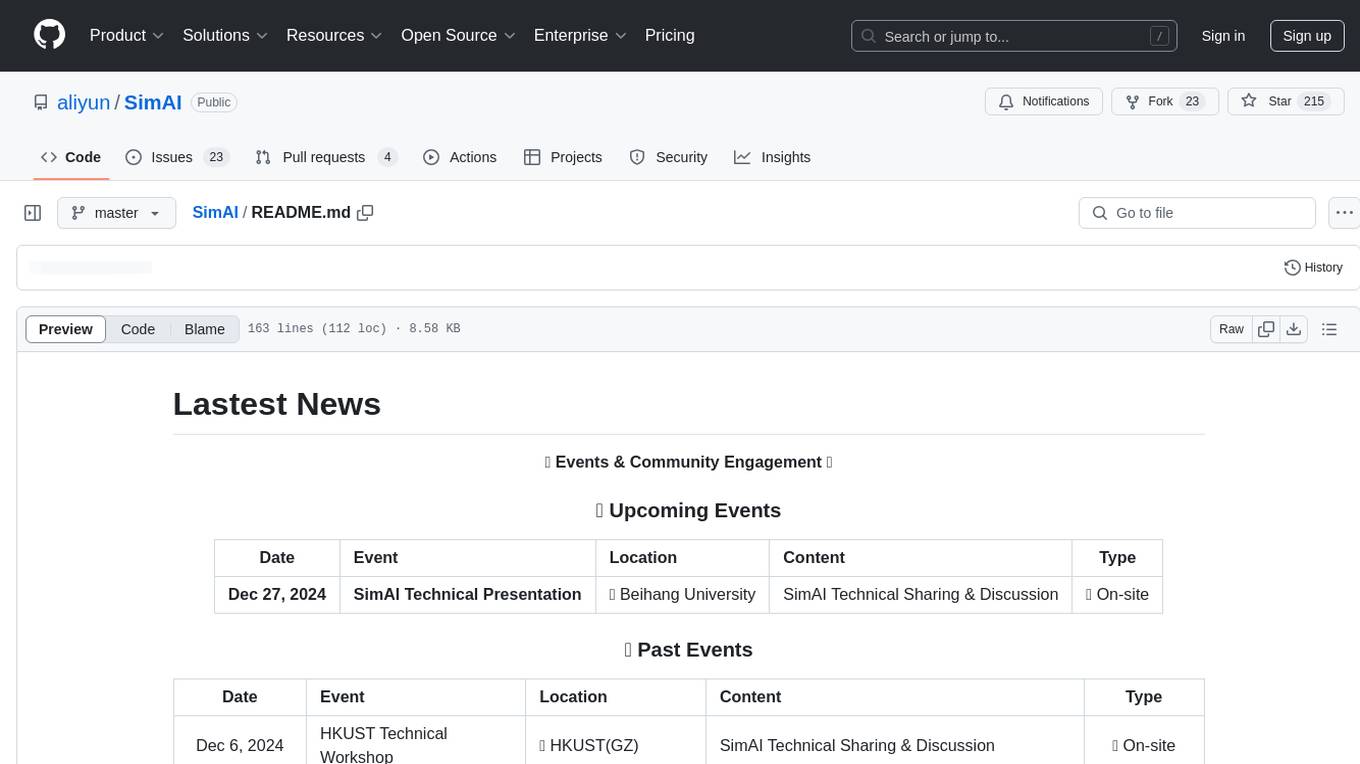
SimAI
SimAI is the industry's first full-stack, high-precision simulator for AI large-scale training. It provides detailed modeling and simulation of the entire LLM training process, encompassing framework, collective communication, network layers, and more. This comprehensive approach offers end-to-end performance data, enabling researchers to analyze training process details, evaluate time consumption of AI tasks under specific conditions, and assess performance gains from various algorithmic optimizations.
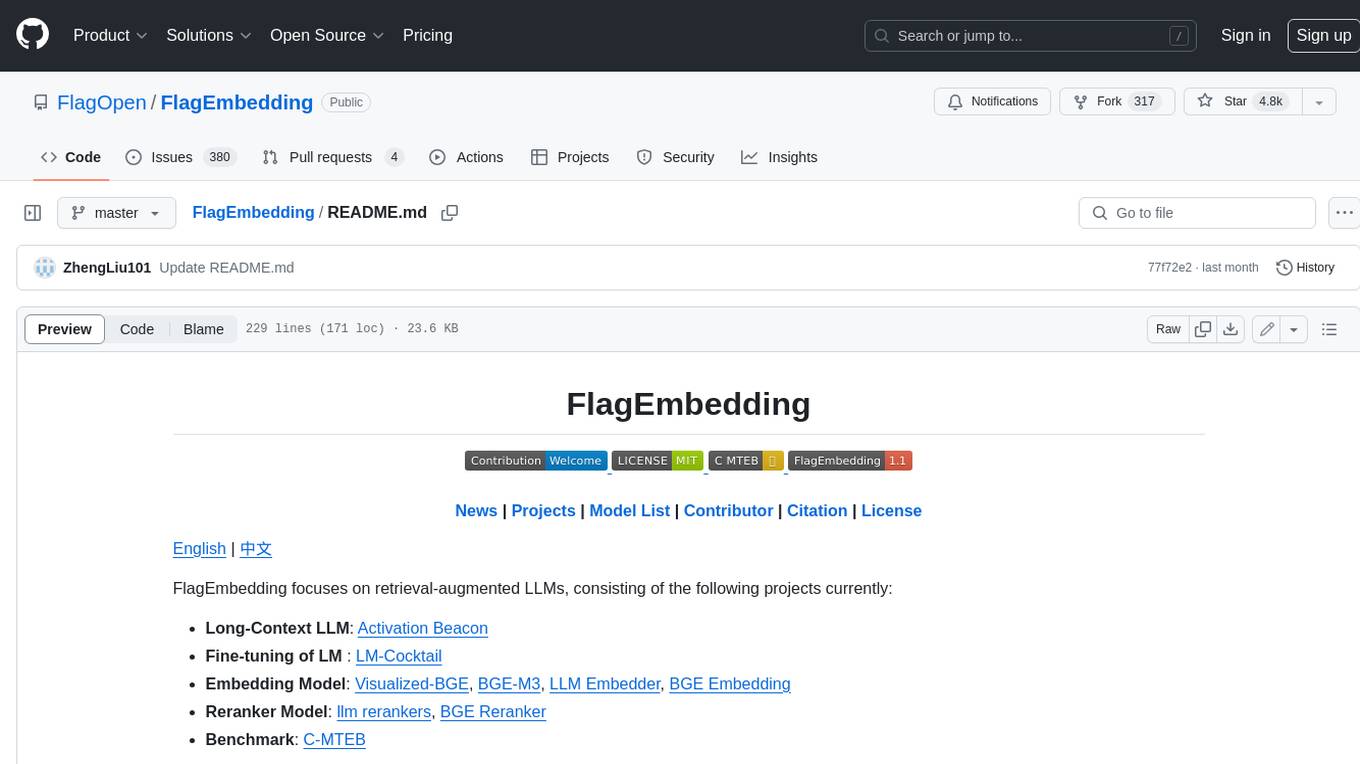
FlagEmbedding
FlagEmbedding focuses on retrieval-augmented LLMs, consisting of the following projects currently: * **Long-Context LLM** : Activation Beacon * **Fine-tuning of LM** : LM-Cocktail * **Embedding Model** : Visualized-BGE, BGE-M3, LLM Embedder, BGE Embedding * **Reranker Model** : llm rerankers, BGE Reranker * **Benchmark** : C-MTEB
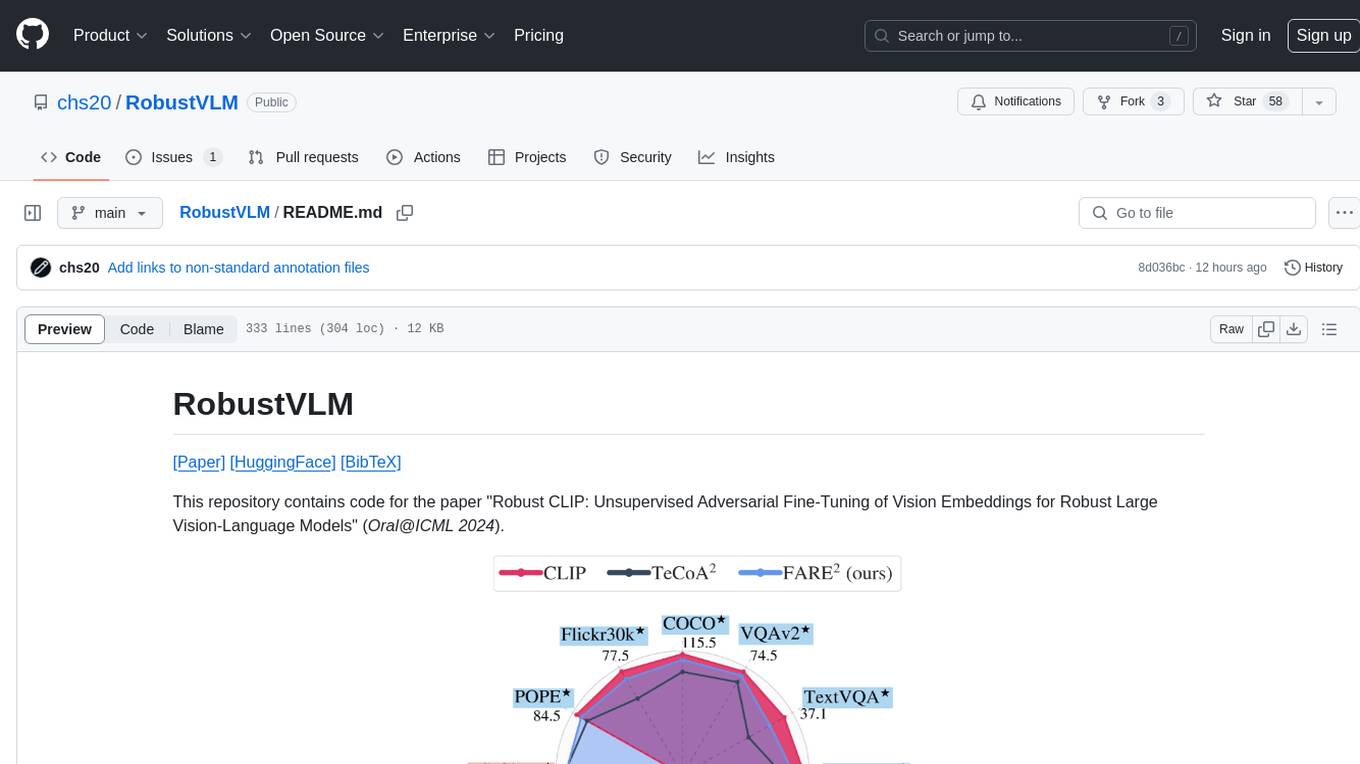
RobustVLM
This repository contains code for the paper 'Robust CLIP: Unsupervised Adversarial Fine-Tuning of Vision Embeddings for Robust Large Vision-Language Models'. It focuses on fine-tuning CLIP in an unsupervised manner to enhance its robustness against visual adversarial attacks. By replacing the vision encoder of large vision-language models with the fine-tuned CLIP models, it achieves state-of-the-art adversarial robustness on various vision-language tasks. The repository provides adversarially fine-tuned ViT-L/14 CLIP models and offers insights into zero-shot classification settings and clean accuracy improvements.
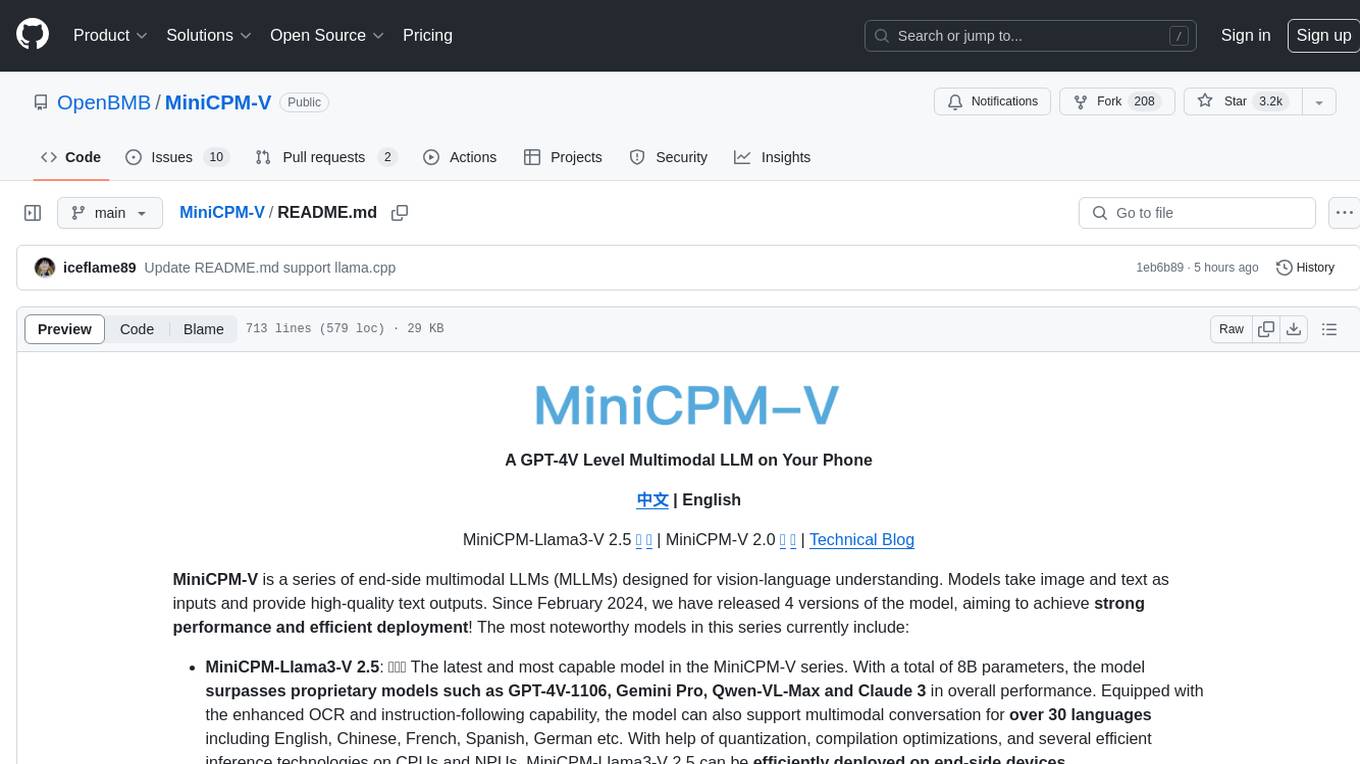
MiniCPM-V
MiniCPM-V is a series of end-side multimodal LLMs designed for vision-language understanding. The models take image and text inputs to provide high-quality text outputs. The series includes models like MiniCPM-Llama3-V 2.5 with 8B parameters surpassing proprietary models, and MiniCPM-V 2.0, a lighter model with 2B parameters. The models support over 30 languages, efficient deployment on end-side devices, and have strong OCR capabilities. They achieve state-of-the-art performance on various benchmarks and prevent hallucinations in text generation. The models can process high-resolution images efficiently and support multilingual capabilities.
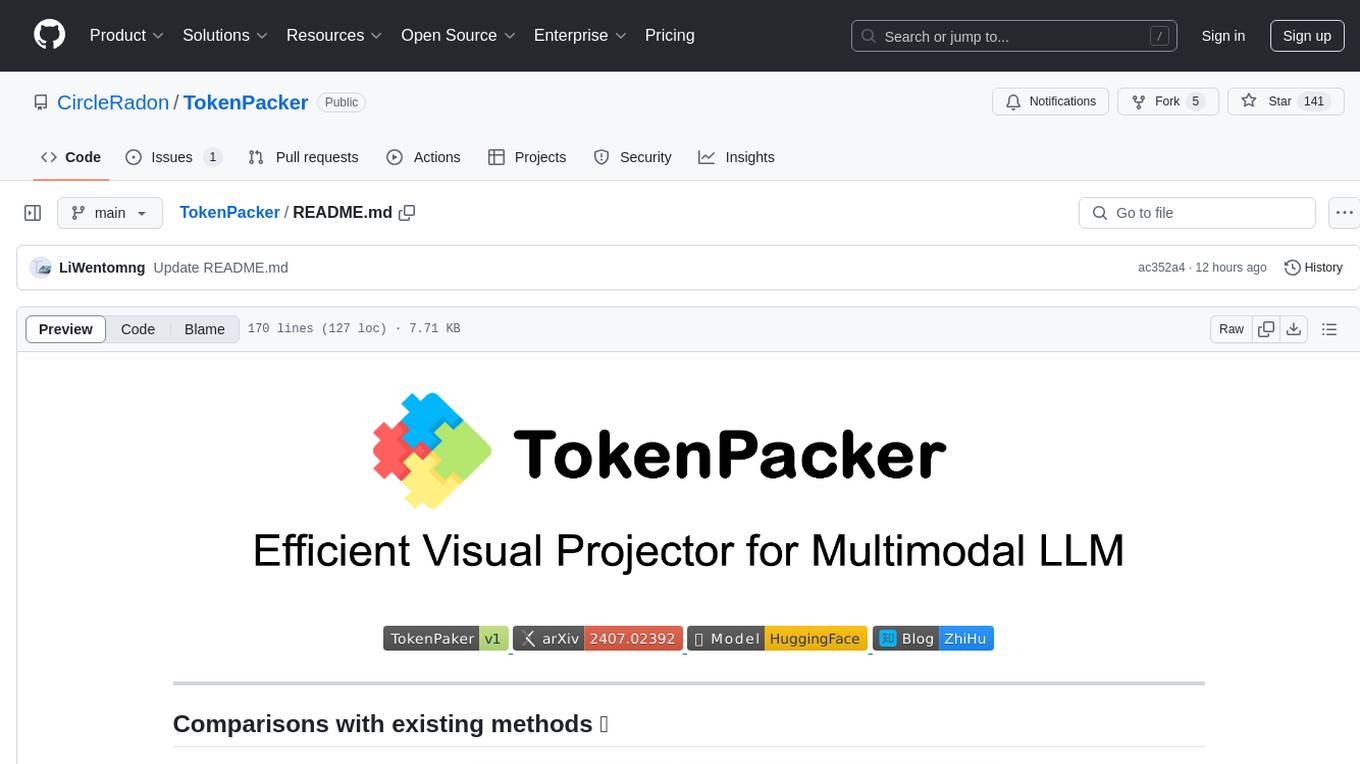
TokenPacker
TokenPacker is a novel visual projector that compresses visual tokens by 75%∼89% with high efficiency. It adopts a 'coarse-to-fine' scheme to generate condensed visual tokens, achieving comparable or better performance across diverse benchmarks. The tool includes TokenPacker for general use and TokenPacker-HD for high-resolution image understanding. It provides training scripts, checkpoints, and supports various compression ratios and patch numbers.
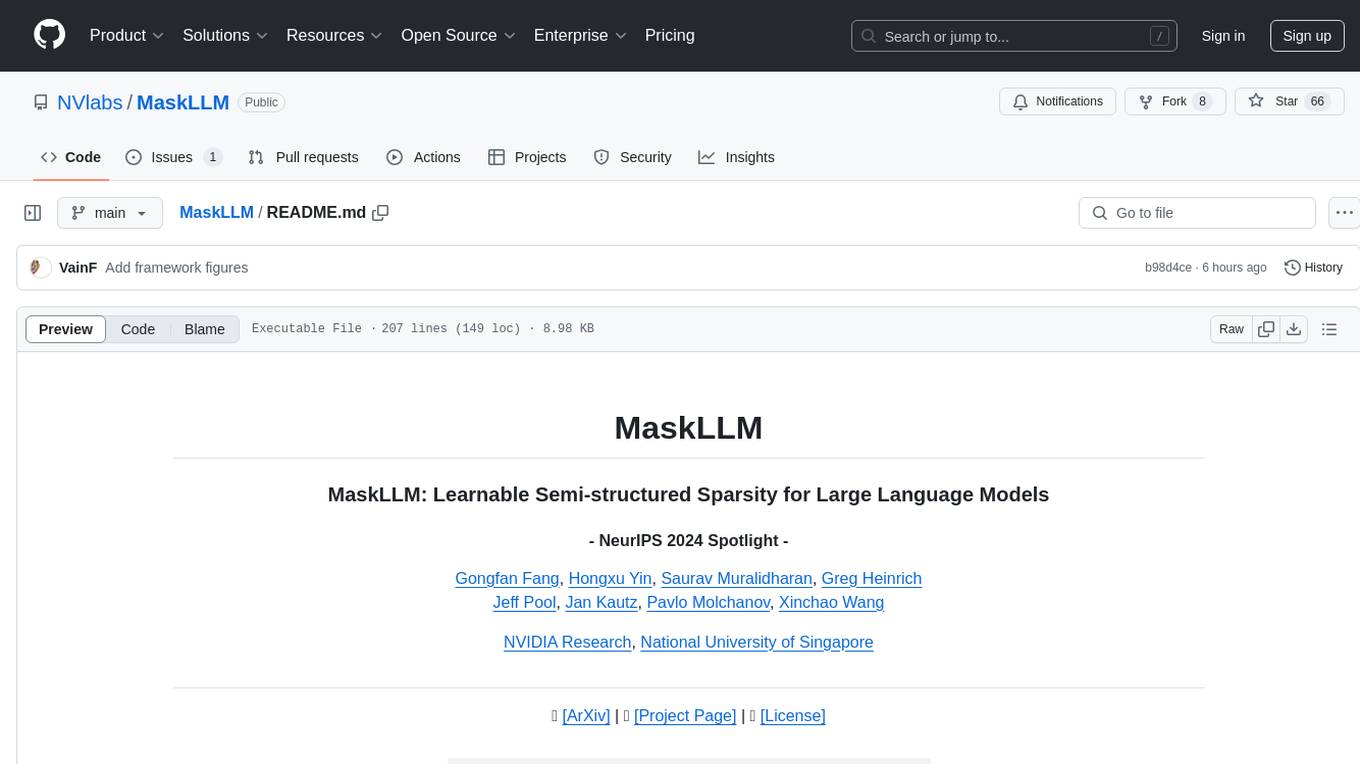
MaskLLM
MaskLLM is a learnable pruning method that establishes Semi-structured Sparsity in Large Language Models (LLMs) to reduce computational overhead during inference. It is scalable and benefits from larger training datasets. The tool provides examples for running MaskLLM with Megatron-LM, preparing LLaMA checkpoints, pre-tokenizing C4 data for Megatron, generating prior masks, training MaskLLM, and evaluating the model. It also includes instructions for exporting sparse models to Huggingface.
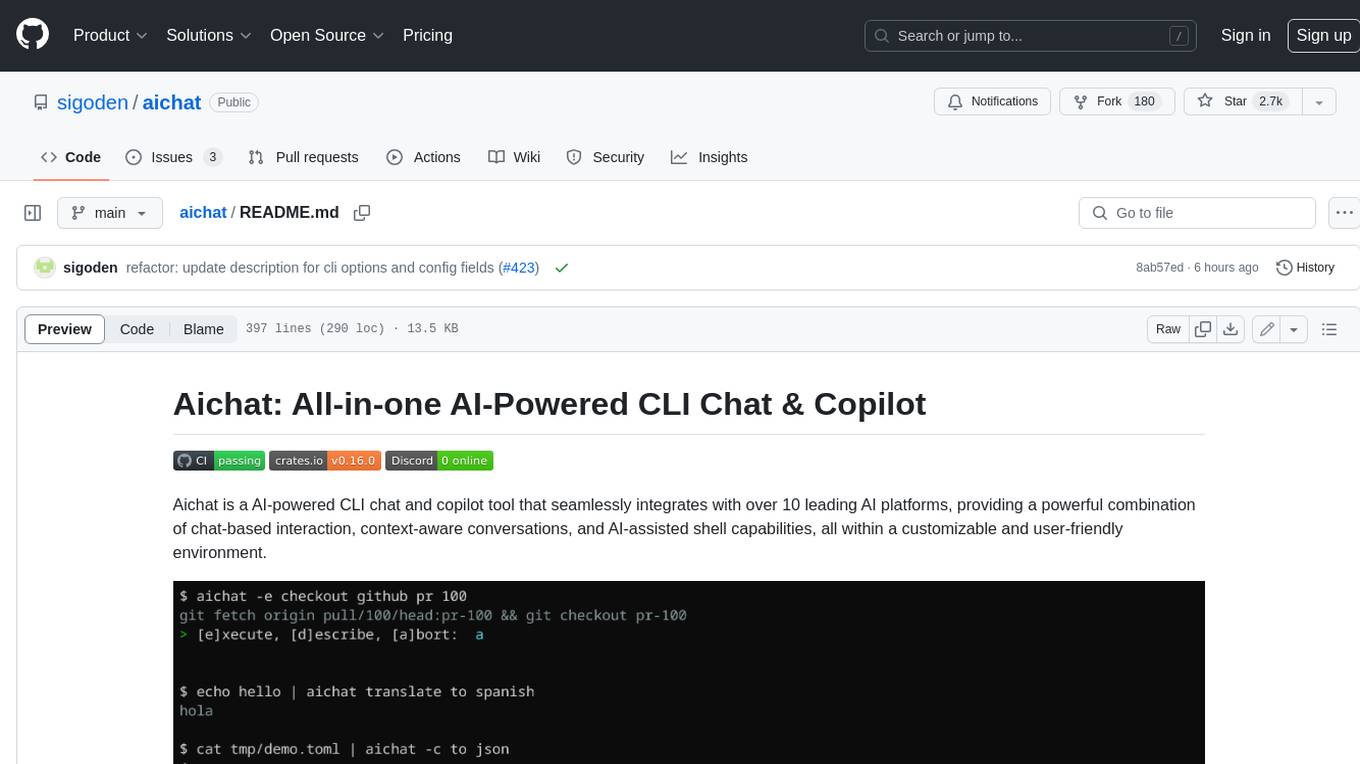
aichat
Aichat is an AI-powered CLI chat and copilot tool that seamlessly integrates with over 10 leading AI platforms, providing a powerful combination of chat-based interaction, context-aware conversations, and AI-assisted shell capabilities, all within a customizable and user-friendly environment.
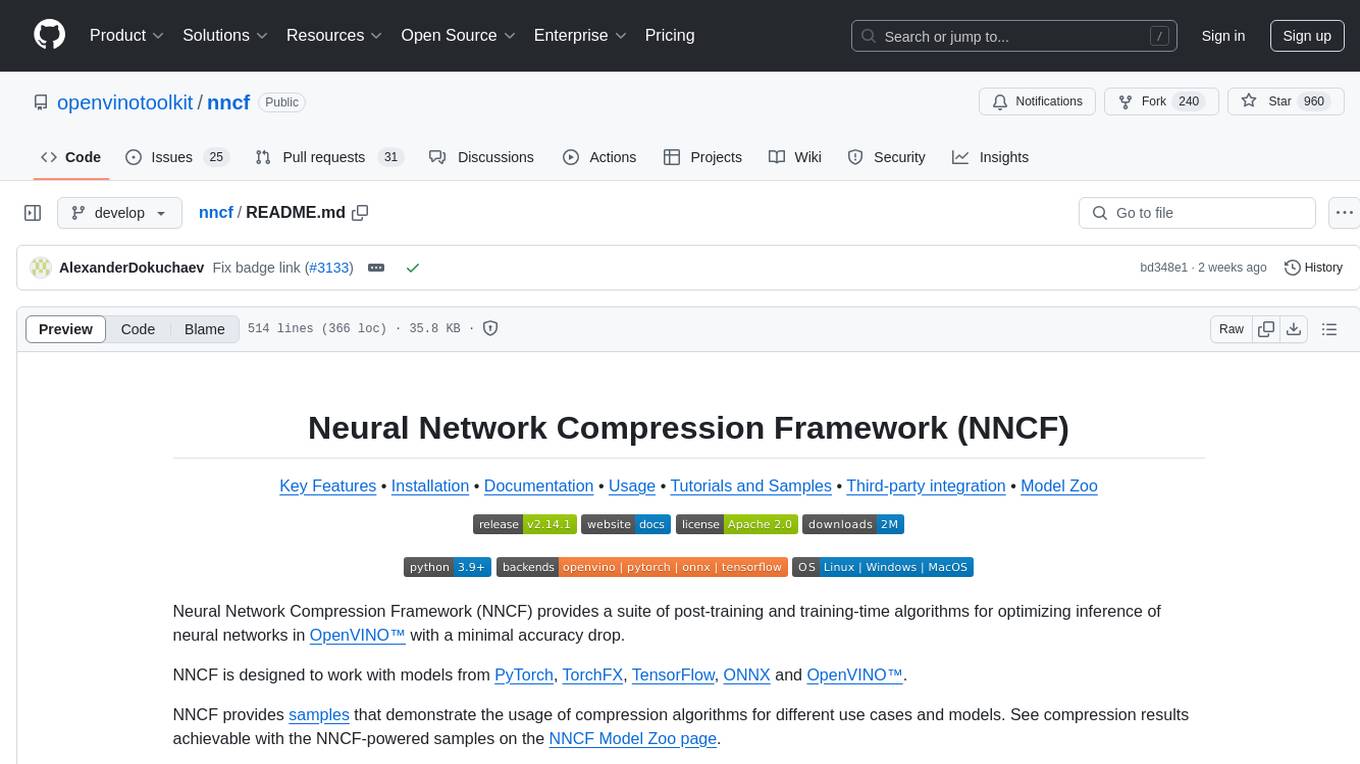
nncf
Neural Network Compression Framework (NNCF) provides a suite of post-training and training-time algorithms for optimizing inference of neural networks in OpenVINO™ with a minimal accuracy drop. It is designed to work with models from PyTorch, TorchFX, TensorFlow, ONNX, and OpenVINO™. NNCF offers samples demonstrating compression algorithms for various use cases and models, with the ability to add different compression algorithms easily. It supports GPU-accelerated layers, distributed training, and seamless combination of pruning, sparsity, and quantization algorithms. NNCF allows exporting compressed models to ONNX or TensorFlow formats for use with OpenVINO™ toolkit, and supports Accuracy-Aware model training pipelines via Adaptive Compression Level Training and Early Exit Training.
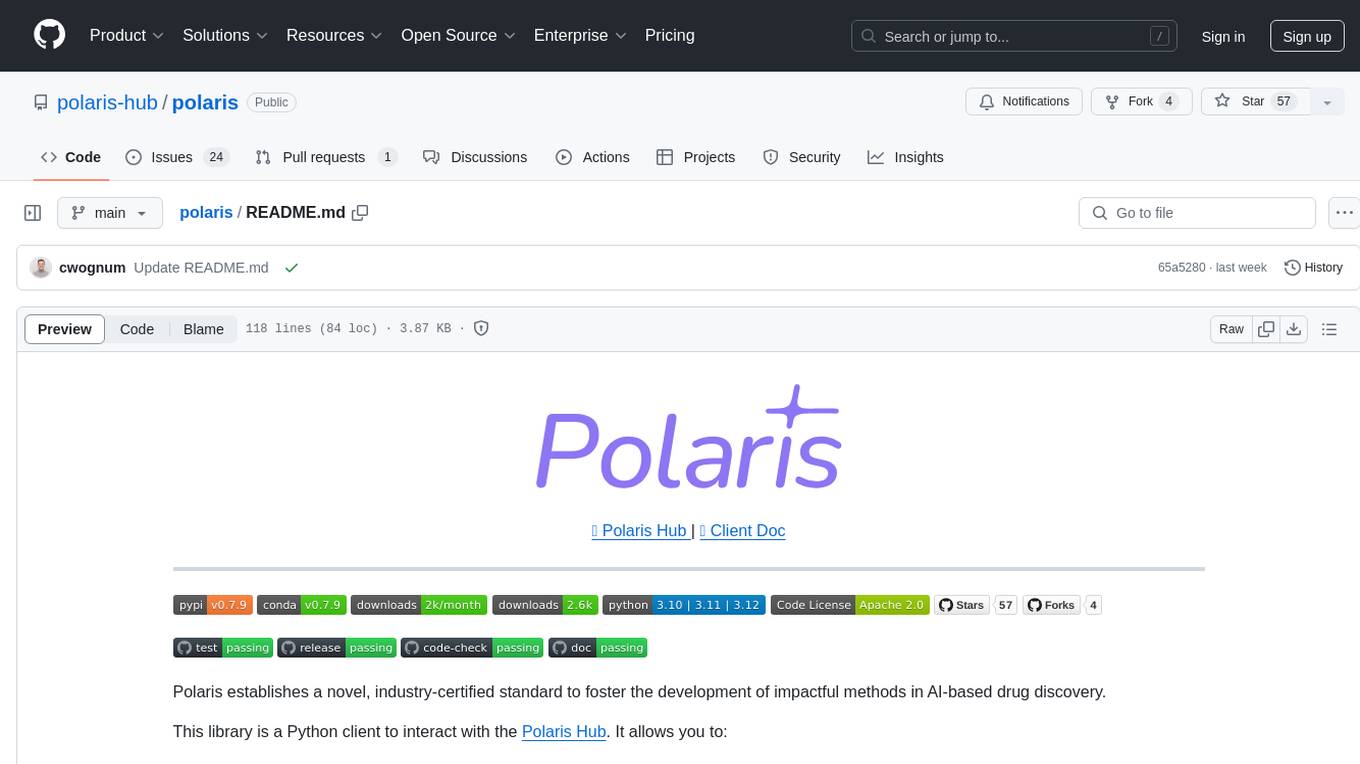
polaris
Polaris establishes a novel, industry‑certified standard to foster the development of impactful methods in AI-based drug discovery. This library is a Python client to interact with the Polaris Hub. It allows you to download Polaris datasets and benchmarks, evaluate a custom method against a Polaris benchmark, and create and upload new datasets and benchmarks.
For similar tasks

ShapeLLM
ShapeLLM is the first 3D Multimodal Large Language Model designed for embodied interaction, exploring a universal 3D object understanding with 3D point clouds and languages. It supports single-view colored point cloud input and introduces a robust 3D QA benchmark, 3D MM-Vet, encompassing various variants. The model extends the powerful point encoder architecture, ReCon++, achieving state-of-the-art performance across a range of representation learning tasks. ShapeLLM can be used for tasks such as training, zero-shot understanding, visual grounding, few-shot learning, and zero-shot learning on 3D MM-Vet.
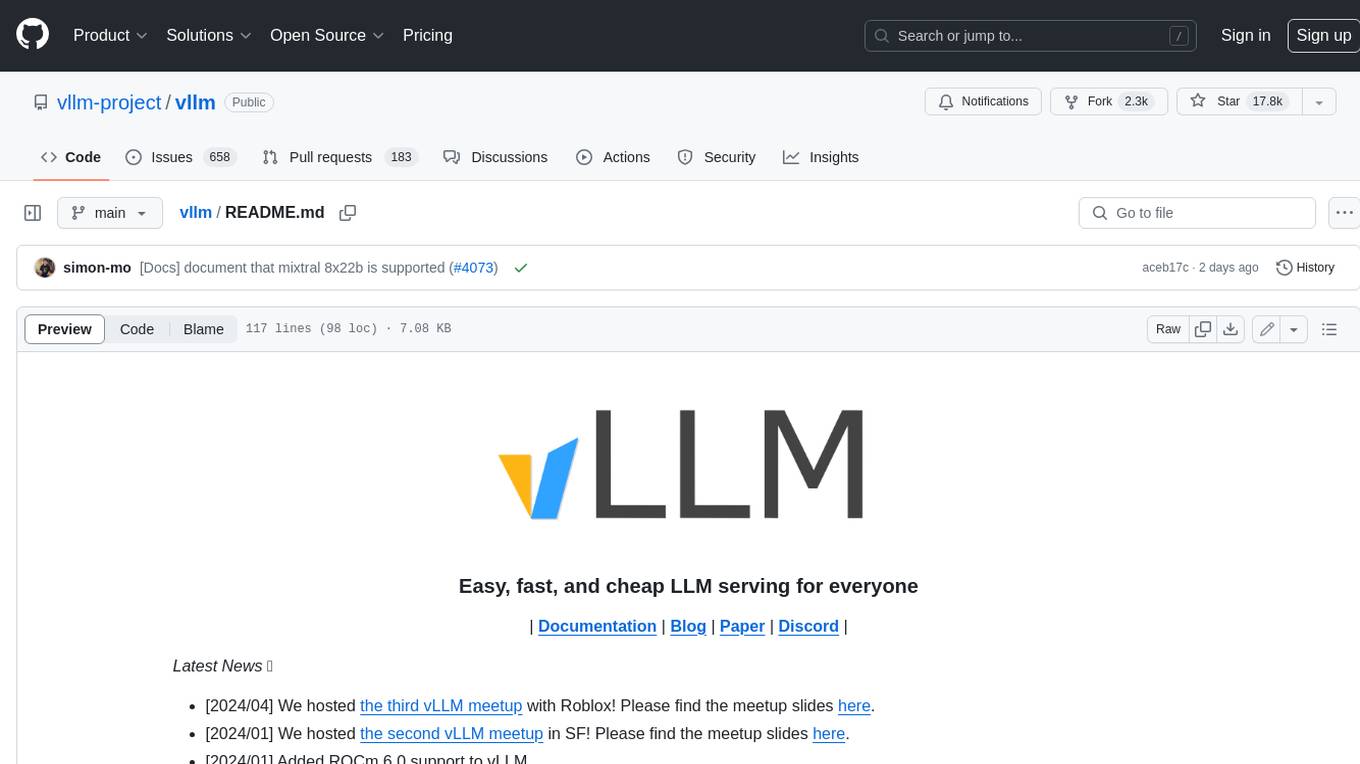
vllm
vLLM is a fast and easy-to-use library for LLM inference and serving. It is designed to be efficient, flexible, and easy to use. vLLM can be used to serve a variety of LLM models, including Hugging Face models. It supports a variety of decoding algorithms, including parallel sampling, beam search, and more. vLLM also supports tensor parallelism for distributed inference and streaming outputs. It is open-source and available on GitHub.
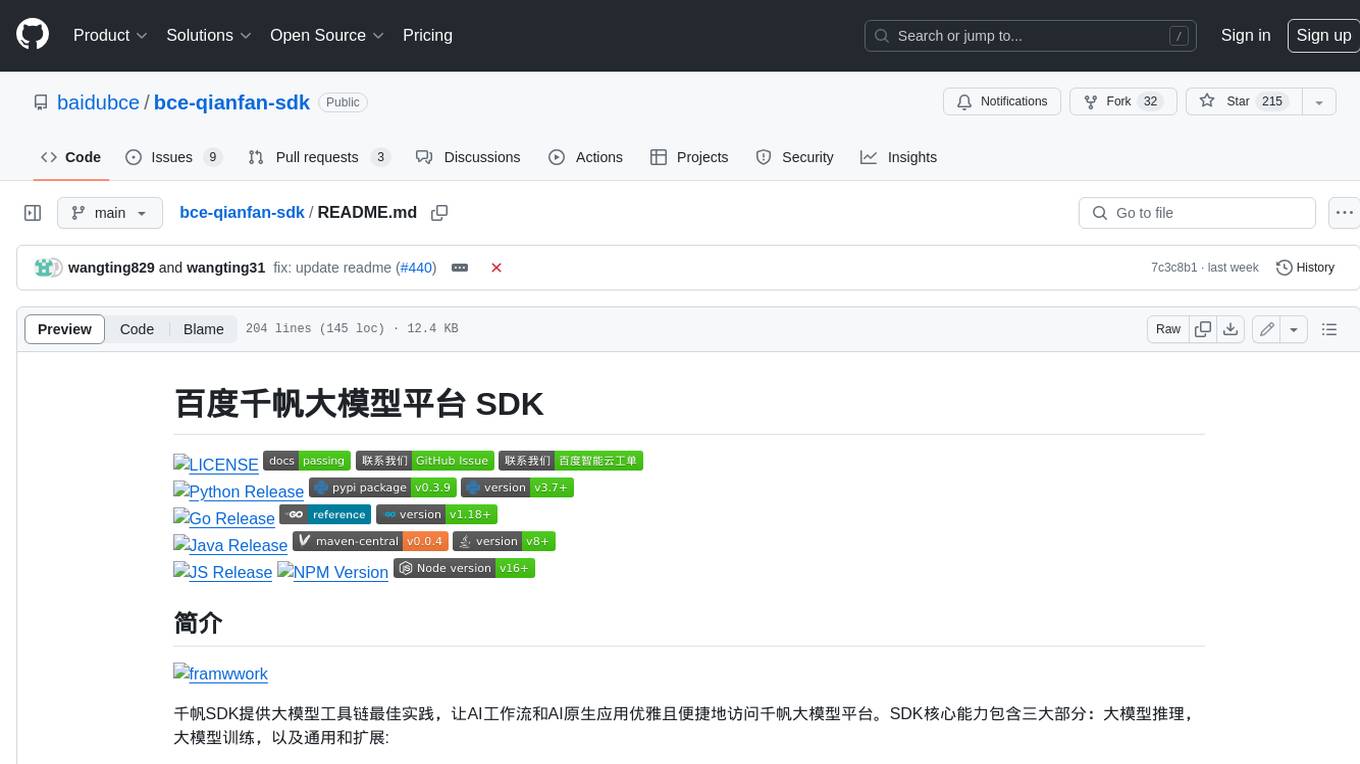
bce-qianfan-sdk
The Qianfan SDK provides best practices for large model toolchains, allowing AI workflows and AI-native applications to access the Qianfan large model platform elegantly and conveniently. The core capabilities of the SDK include three parts: large model reasoning, large model training, and general and extension: * `Large model reasoning`: Implements interface encapsulation for reasoning of Yuyan (ERNIE-Bot) series, open source large models, etc., supporting dialogue, completion, Embedding, etc. * `Large model training`: Based on platform capabilities, it supports end-to-end large model training process, including training data, fine-tuning/pre-training, and model services. * `General and extension`: General capabilities include common AI development tools such as Prompt/Debug/Client. The extension capability is based on the characteristics of Qianfan to adapt to common middleware frameworks.
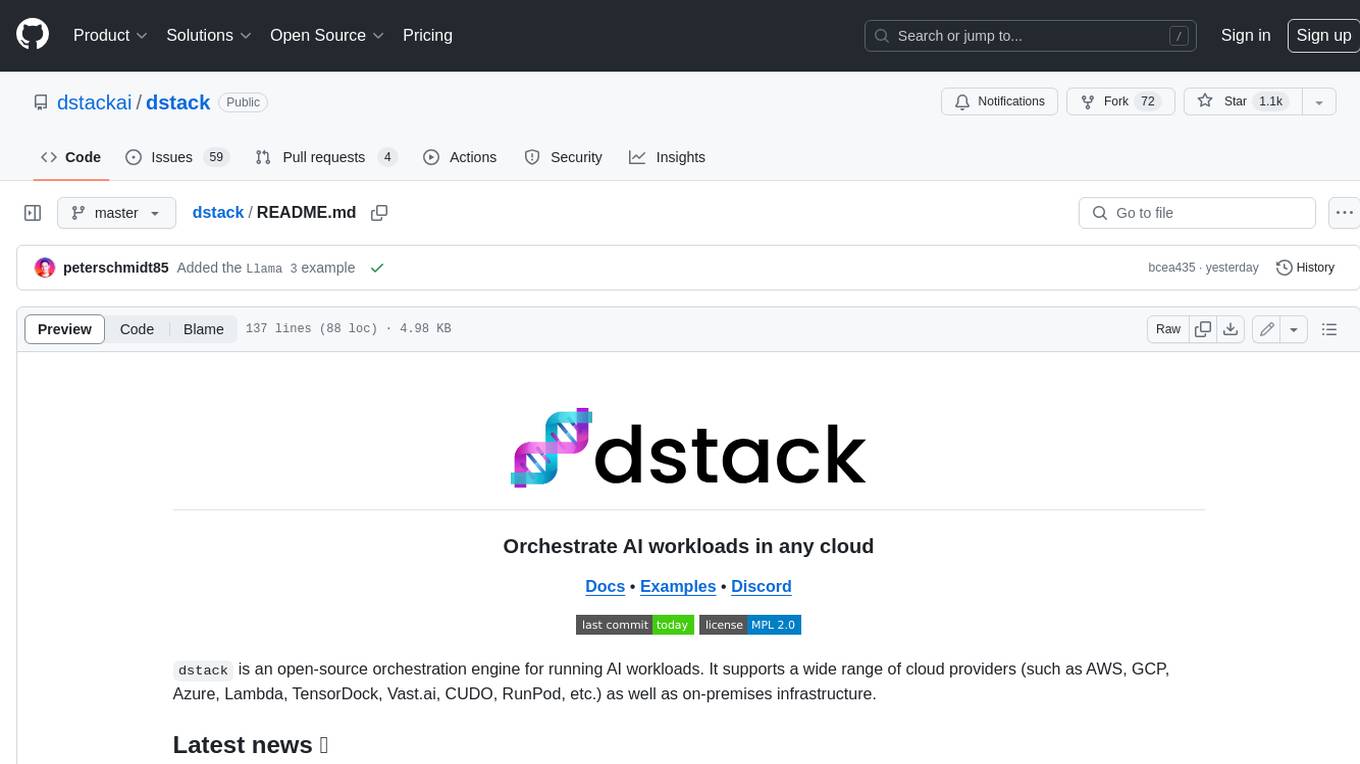
dstack
Dstack is an open-source orchestration engine for running AI workloads in any cloud. It supports a wide range of cloud providers (such as AWS, GCP, Azure, Lambda, TensorDock, Vast.ai, CUDO, RunPod, etc.) as well as on-premises infrastructure. With Dstack, you can easily set up and manage dev environments, tasks, services, and pools for your AI workloads.
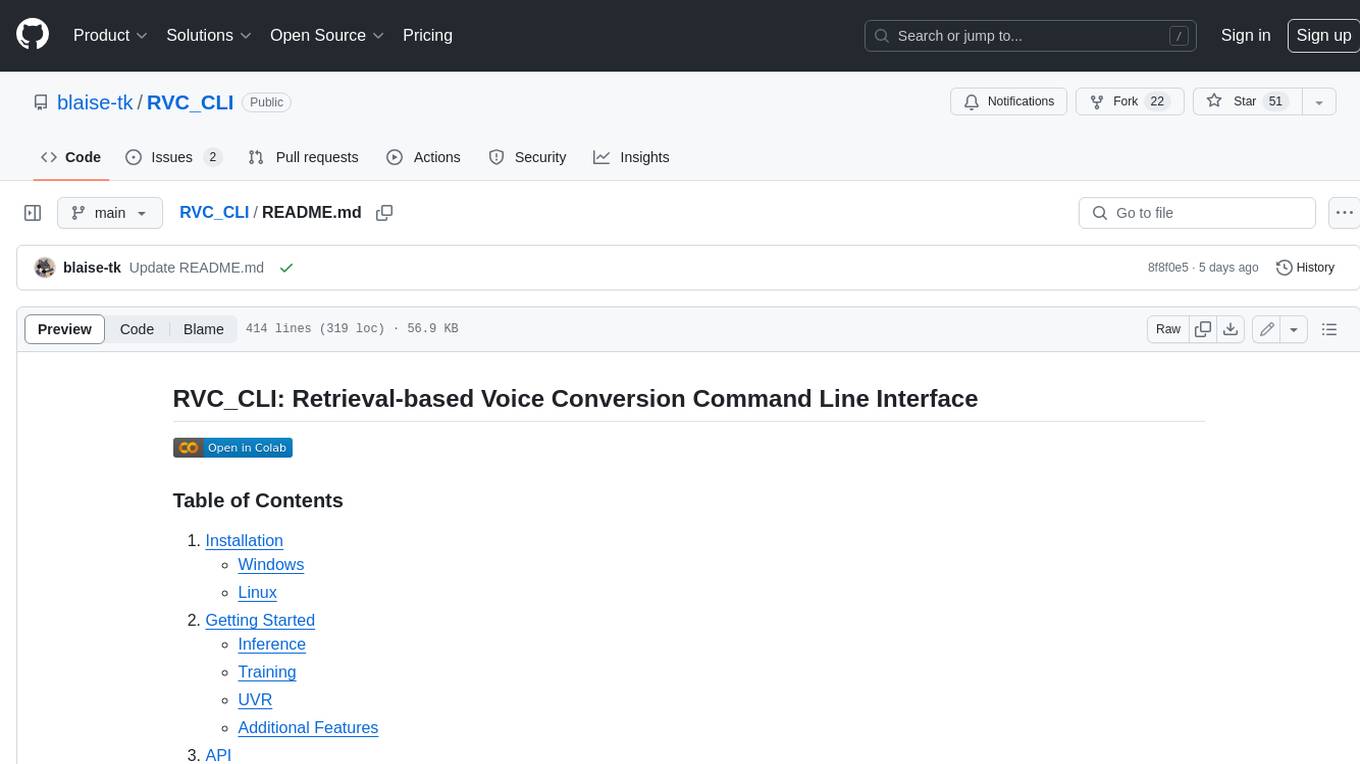
RVC_CLI
**RVC_CLI: Retrieval-based Voice Conversion Command Line Interface** This command-line interface (CLI) provides a comprehensive set of tools for voice conversion, enabling you to modify the pitch, timbre, and other characteristics of audio recordings. It leverages advanced machine learning models to achieve realistic and high-quality voice conversions. **Key Features:** * **Inference:** Convert the pitch and timbre of audio in real-time or process audio files in batch mode. * **TTS Inference:** Synthesize speech from text using a variety of voices and apply voice conversion techniques. * **Training:** Train custom voice conversion models to meet specific requirements. * **Model Management:** Extract, blend, and analyze models to fine-tune and optimize performance. * **Audio Analysis:** Inspect audio files to gain insights into their characteristics. * **API:** Integrate the CLI's functionality into your own applications or workflows. **Applications:** The RVC_CLI finds applications in various domains, including: * **Music Production:** Create unique vocal effects, harmonies, and backing vocals. * **Voiceovers:** Generate voiceovers with different accents, emotions, and styles. * **Audio Editing:** Enhance or modify audio recordings for podcasts, audiobooks, and other content. * **Research and Development:** Explore and advance the field of voice conversion technology. **For Jobs:** * Audio Engineer * Music Producer * Voiceover Artist * Audio Editor * Machine Learning Engineer **AI Keywords:** * Voice Conversion * Pitch Shifting * Timbre Modification * Machine Learning * Audio Processing **For Tasks:** * Convert Pitch * Change Timbre * Synthesize Speech * Train Model * Analyze Audio
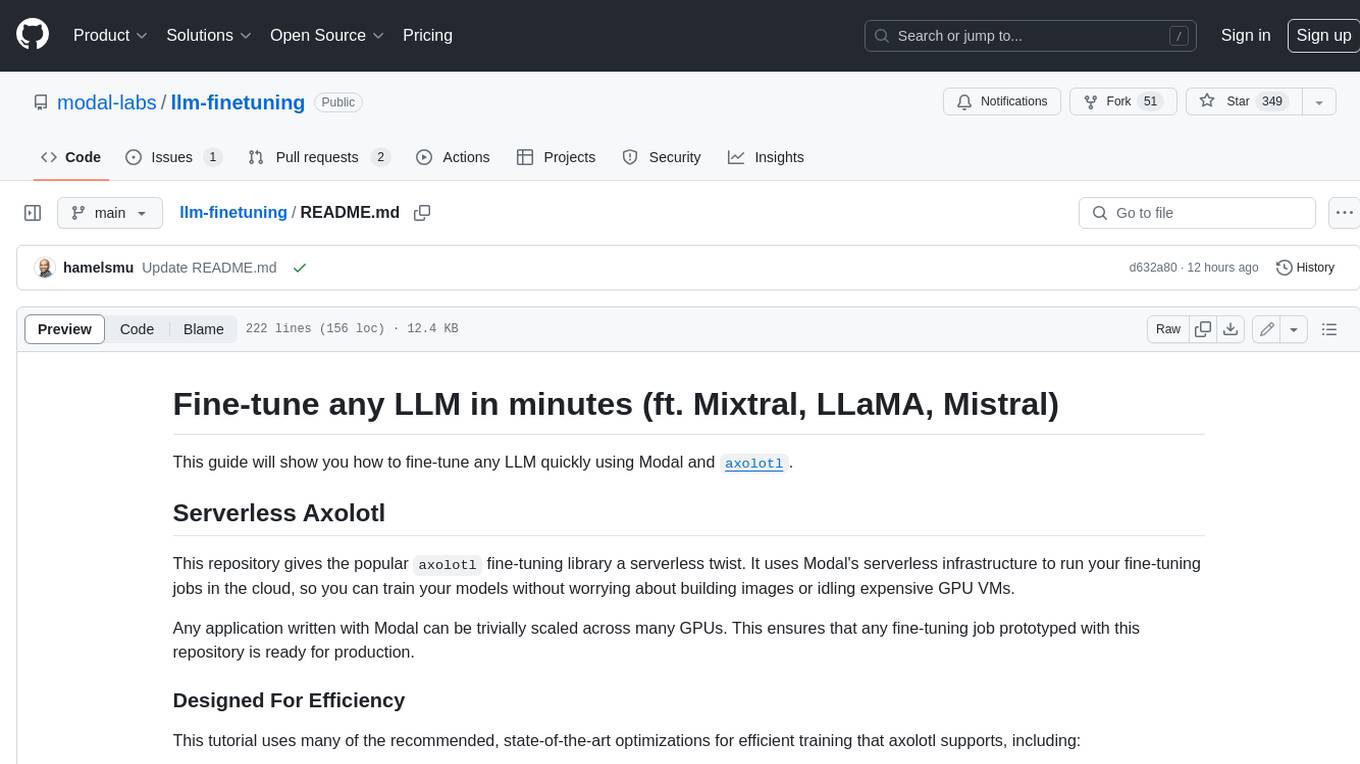
llm-finetuning
llm-finetuning is a repository that provides a serverless twist to the popular axolotl fine-tuning library using Modal's serverless infrastructure. It allows users to quickly fine-tune any LLM model with state-of-the-art optimizations like Deepspeed ZeRO, LoRA adapters, Flash attention, and Gradient checkpointing. The repository simplifies the fine-tuning process by not exposing all CLI arguments, instead allowing users to specify options in a config file. It supports efficient training and scaling across multiple GPUs, making it suitable for production-ready fine-tuning jobs.
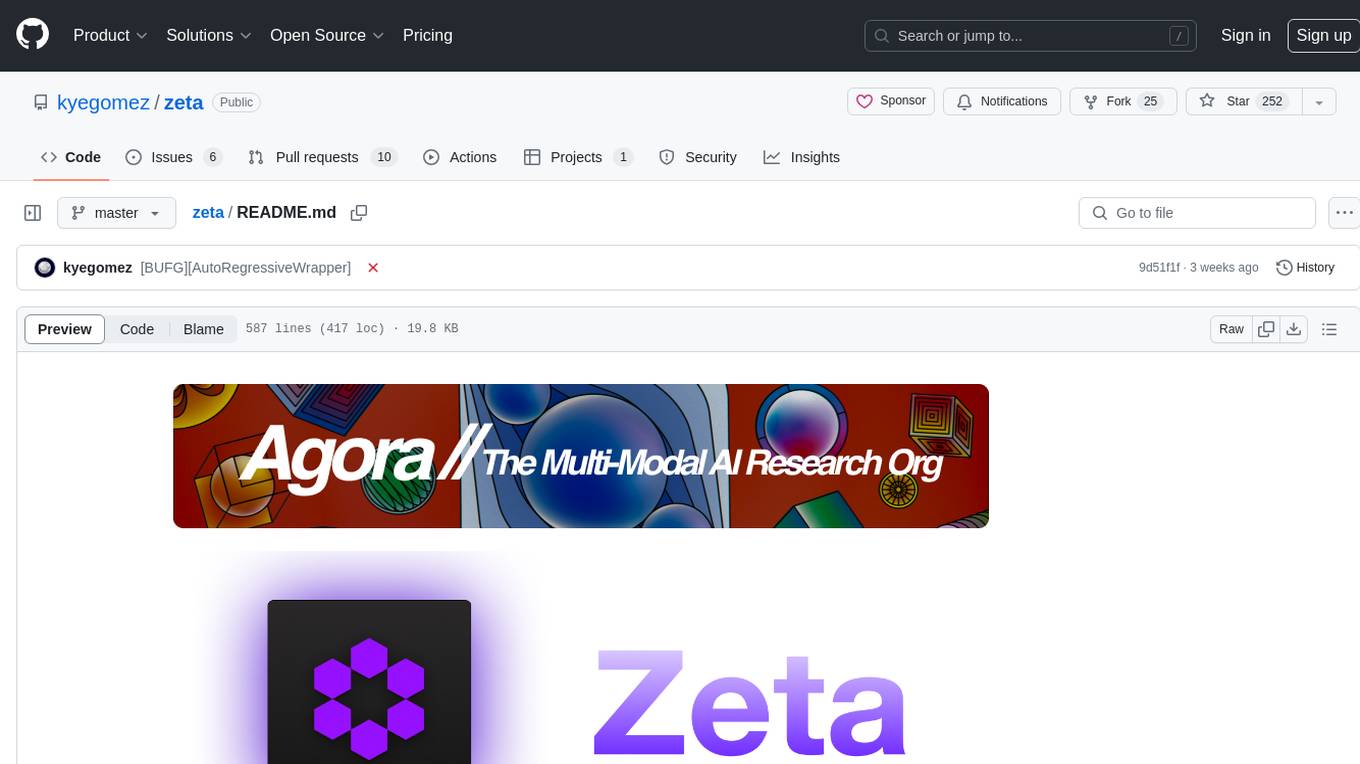
zeta
Zeta is a tool designed to build state-of-the-art AI models faster by providing modular, high-performance, and scalable building blocks. It addresses the common issues faced while working with neural nets, such as chaotic codebases, lack of modularity, and low performance modules. Zeta emphasizes usability, modularity, and performance, and is currently used in hundreds of models across various GitHub repositories. It enables users to prototype, train, optimize, and deploy the latest SOTA neural nets into production. The tool offers various modules like FlashAttention, SwiGLUStacked, RelativePositionBias, FeedForward, BitLinear, PalmE, Unet, VisionEmbeddings, niva, FusedDenseGELUDense, FusedDropoutLayerNorm, MambaBlock, Film, hyper_optimize, DPO, and ZetaCloud for different tasks in AI model development.
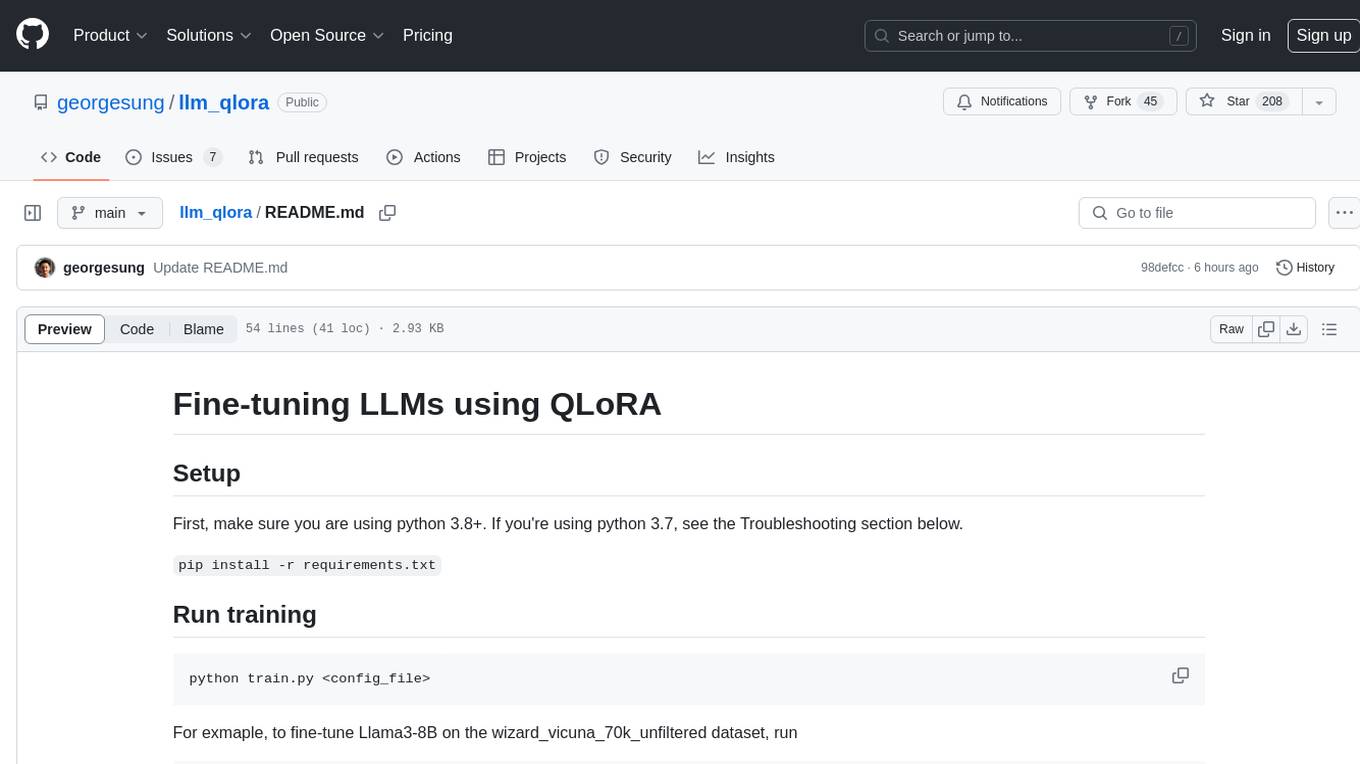
llm_qlora
LLM_QLoRA is a repository for fine-tuning Large Language Models (LLMs) using QLoRA methodology. It provides scripts for training LLMs on custom datasets, pushing models to HuggingFace Hub, and performing inference. Additionally, it includes models trained on HuggingFace Hub, a blog post detailing the QLoRA fine-tuning process, and instructions for converting and quantizing models. The repository also addresses troubleshooting issues related to Python versions and dependencies.
For similar jobs

weave
Weave is a toolkit for developing Generative AI applications, built by Weights & Biases. With Weave, you can log and debug language model inputs, outputs, and traces; build rigorous, apples-to-apples evaluations for language model use cases; and organize all the information generated across the LLM workflow, from experimentation to evaluations to production. Weave aims to bring rigor, best-practices, and composability to the inherently experimental process of developing Generative AI software, without introducing cognitive overhead.

LLMStack
LLMStack is a no-code platform for building generative AI agents, workflows, and chatbots. It allows users to connect their own data, internal tools, and GPT-powered models without any coding experience. LLMStack can be deployed to the cloud or on-premise and can be accessed via HTTP API or triggered from Slack or Discord.

VisionCraft
The VisionCraft API is a free API for using over 100 different AI models. From images to sound.

kaito
Kaito is an operator that automates the AI/ML inference model deployment in a Kubernetes cluster. It manages large model files using container images, avoids tuning deployment parameters to fit GPU hardware by providing preset configurations, auto-provisions GPU nodes based on model requirements, and hosts large model images in the public Microsoft Container Registry (MCR) if the license allows. Using Kaito, the workflow of onboarding large AI inference models in Kubernetes is largely simplified.

PyRIT
PyRIT is an open access automation framework designed to empower security professionals and ML engineers to red team foundation models and their applications. It automates AI Red Teaming tasks to allow operators to focus on more complicated and time-consuming tasks and can also identify security harms such as misuse (e.g., malware generation, jailbreaking), and privacy harms (e.g., identity theft). The goal is to allow researchers to have a baseline of how well their model and entire inference pipeline is doing against different harm categories and to be able to compare that baseline to future iterations of their model. This allows them to have empirical data on how well their model is doing today, and detect any degradation of performance based on future improvements.

tabby
Tabby is a self-hosted AI coding assistant, offering an open-source and on-premises alternative to GitHub Copilot. It boasts several key features: * Self-contained, with no need for a DBMS or cloud service. * OpenAPI interface, easy to integrate with existing infrastructure (e.g Cloud IDE). * Supports consumer-grade GPUs.

spear
SPEAR (Simulator for Photorealistic Embodied AI Research) is a powerful tool for training embodied agents. It features 300 unique virtual indoor environments with 2,566 unique rooms and 17,234 unique objects that can be manipulated individually. Each environment is designed by a professional artist and features detailed geometry, photorealistic materials, and a unique floor plan and object layout. SPEAR is implemented as Unreal Engine assets and provides an OpenAI Gym interface for interacting with the environments via Python.

Magick
Magick is a groundbreaking visual AIDE (Artificial Intelligence Development Environment) for no-code data pipelines and multimodal agents. Magick can connect to other services and comes with nodes and templates well-suited for intelligent agents, chatbots, complex reasoning systems and realistic characters.














